Numerical Simulation of Dynamic Variation Characteristics of Particles in a Rolling Fluidized Bed
Abstract
1. Introduction
- (1)
- Research on gas–solid dense phase fluidized bed for marine fluidized bed boiler
- (2)
- Study on gas–solid circulating fluidized bed for marine diesel engine exhaust purification and waste heat utilization
- (3)
- Research on gas–solid dense phase fluidized bed for offshore floating platform oil and gas resource processing and solid waste treatment
2. Numerical Simulation
2.1. Experimental Devices and Process
2.2. Modeling and Meshing
2.3. Numerical Method and Model
2.4. Model Validation
3. Results and Discussion
3.1. Dynamic Variation Characteristics of Solid Holdup Signal
3.2. Time Variation Characteristics of Solid Circulating Rate
3.3. Lag Phenomenon in the Lower Wall Region of Inclined Bed
- (1)
- gsin(Θ)
- (2)
- 2usω
- (3)
- rαω
4. Conclusions
- (1)
- In the periodic rolling of the bed, the gas–solid accumulation state changes in the wall region, and the transient solid content signal shows periodic transition characteristics accordingly. The solid holdup in the lower wall region fluctuates at a low amplitude around high values. Meanwhile, the upper wall region has a high frequency and amplitude of solid holdup fluctuations. The characteristics of this periodic transition gradually weakens as the position moves toward the center line of the bed. At the center of the bed, its fluctuation pattern is similar to that in the upright bed.
- (2)
- The solid flow rate direction in the region near the center line of the rolling bed always remains upward, which is similar to that in the upright bed. The particles in the upper/lower wall region of the inclined bed are in an internal circulation flow mode. There is the gas phase aggregation in the upper wall region of the inclined bed, with the upward solid flow rate. On the contrary, the particle phase accumulates in the lower wall region of the inclined bed, with the downward solid flow rate.
- (3)
- Compared with the instantaneous inclination angle increase stage, there is a ‘lag phenomenon’ when the inclination angle decreases. Mainly affected by the change in the Coriolis force, the downward solid flow rate does not change synchronously with the decrease in the inclination angle. It is not conducive to the fluidization of the gas–solid two-phase in the bed, and thus, further reduces the efficiency of the fluidized bed.
Author Contributions
Funding
Data Availability Statement
Acknowledgments
Conflicts of Interest
Nomenclature
| dp | Average particle size of particle in bed | mm |
| Acceleration of gravity | m/s2 | |
| Initial loading height of the bed | mm | |
| Axial height of the bed | m | |
| Pressure of fluidized bed | Pa | |
| Pb | Pressure drop in the fluidized bed | Pa |
| Particle flow rate | kg/s | |
| Radius of curvature of the force point with rolling of the bed | m | |
| S | Standard deviation of solid holdup | Dimensionless |
| Rolling period | s | |
| Transient rolling moment | s | |
| ug | Gas velocity | m/s |
| umf | Minimum fluidization velocity | m/s |
| Vs | Particle volume | m3 |
| Position of two-dimensional bed in horizontal direction | mm | |
| Position of two-dimensional bed along axial height direction | mm | |
| αω | Instantaneous angular acceleration of bed rolling | rad/s2 |
| εi | Component volume fraction | Dimensionless |
| εmf | Critical gas volume fraction | Dimensionless |
| Specularity coefficient | Dimensionless | |
| μi | Component viscosity | Pa·s |
| Θ | Rolling amplitude of rolling fluidized bed and inclination angle of inclined bed | ° |
| Instantaneous rolling angle | ° | |
| ρi | Dielectric density | kg/m3 |
| ρp | Particle bulk density | kg/m3 |
| Instantaneous rolling angular velocity | rad/s | |
| Subscripts | ||
| i | Species in the bed | |
| g | Gas | |
| s | Particle |
References
- Du, C.S.; Wang, Z.F.; He, Y.L.; Qiu, H.W. Development law of floating production platform and development trend of South China Sea. New Technol. New Prod. China 2021, 9, 133–136. [Google Scholar]
- Zhang, L.L.; Fu, J.W.; Luo, Y.; Sun, B.C.; Zou, H.K.; Chu, G.W.; Chen, J.F. Technology and application of supergravity process strengthening for offshore engineering. J. Chem. Ind. Eng. 2020, 71, 1–15. [Google Scholar]
- Hong, G.H.; Moon, D.J. Development of fixed bed reactor for application in GTL-FPSO: The effect of nitrogen and carbon dioxide contents in feed gas on Fischer-Tropsch synthesis reaction over Ru/Co/Al2O3 catalyst. Catal. Today 2020, 353, 73–81. [Google Scholar] [CrossRef]
- Xu, P.F. Numerical Simulation and Structural Optimization Design of Two-Phase Flow Characteristics in Gas-Solid Fluidized Bed. Master’s Thesis, Qingdao University of Science and Technology, Shandong, China, 2020. [Google Scholar]
- Dashliborun, A.M.; Larachi, F.; Taghavi, S.M. Gas-liquid mass-transfer behavior of packed-bed scrubbers for floating/offshore CO2 capture. Chem. Eng. J. 2019, 377, 119236. [Google Scholar] [CrossRef]
- Iliuta, I.; Larachi, F. Fischer-Tropsch synthesis in vertical, inclined and oscillating trickle-bed reactors for offshore floating applications. Chem. Eng. Sci. 2018, 177, 509–522. [Google Scholar] [CrossRef]
- Dashliborun, A.M.; Füssel, A.; Larachi, F. Prospect of open-cell solid foams for floating-platform multiphase reactor applications—Maldistribution susceptibility and hydrodynamic behavior. Chem. Eng. J. 2018, 32, 596–607. [Google Scholar] [CrossRef]
- Sun, X.Z.; Li, Y.X.; Han, H.; Zhu, J.; Wang, S.; Liu, L. Experimental and numerical simulation study on the offshore adaptability of spiral wound heat exchanger in LNG-FPSO DMR natural gas liquefaction process. Energy 2019, 189, 116–178. [Google Scholar] [CrossRef]
- Dashliborun, A.M.; Zhang, J.; Taghavi, S.M.; Larachi, F. Marinization of Multiphase Reactors through the Prism of Chemical Engineers. Ind. Eng. Chem. Res. 2019, 58, 2607–2630. [Google Scholar] [CrossRef]
- Yasui, T.; Nakayama, T.; Yoshida, K. Heat-transfer characteristics in a rocking fluidized bed. Int. Commun. Heat Mass Transf. 1984, 11, 477–488. [Google Scholar] [CrossRef]
- Nishi, Y. Characteristics of fluidized bed under oscillation. Kagaku Kogaku Ronbunshu 1986, 12, 414–419. [Google Scholar] [CrossRef]
- Namie, S.; Osanai, T.; Yamanouchi, H.; Yokomura, T. Investigation on Fluidized Bed Combustion for Marine Application. J. Mar. Eng. Soc. Jpn. 1984, 19, 943–950. [Google Scholar] [CrossRef]
- Zhao, S. Research on Marine Fluidized Bed Waste Gas Boiler. Ship Sci. Technol. 1992, 3, 13–18. [Google Scholar]
- Murata, H.; Oka, H.; Adachi, M.; Harumi, K. Effects of the ship motion on gas-solid flow and heat transfer in a circulating fluidized bed. Powder Technol. 2012, 231, 7–17. [Google Scholar] [CrossRef]
- Zhao, T.; Liu, K.; Murata, H.; Harumi, K.; Takei, M. Experimental and numerical investigation of particle distribution behaviors in a rolling circulating fluidized bed. Powder Technol. 2014, 258, 38–48. [Google Scholar] [CrossRef]
- Zhao, T.; Liu, K.; Murata, H.; Harumi, K.; Takei, M. Investigation of bed-to-wall heat transfer characteristics in a rolling circulating fluidized bed. Powder Technol. 2015, 269, 46–54. [Google Scholar] [CrossRef]
- Zhao, T.; Nakamura, Y.; Liu, K.; Murata, H.; Takei, M. The effect of rolling amplitude and period on particle distribution behavior in a rolling circulating fluidized bed. Powder Technol. 2016, 294, 484–492. [Google Scholar] [CrossRef]
- Tian, P.; Wang, D.W.; Wang, R.J.; Tang, M.; Hao, X.L.; Zhang, S.F. Gas-solid flow characteristics of oscillating fluidized bed. J. Chem. Ind. Eng. 2021, 72, 5102–5113. [Google Scholar]
- Tian, P. Fluidization Characteristics of Gas-Solid Rolling Fluidized Bed. Master’s Thesis, Hebei University of Technology, Tianjin, China, 2021. [Google Scholar]
- Ma, S.H. Numerical Simulation of Geldart A Granular Packed Bed. Master’s Thesis, Hebei University of Technology, Tianjin, China, 2019. [Google Scholar]
- Sun, M.Y.; Yu, C.B.; Lv, D.; Wei, L.B. Adaptability of models with different liquid-solid momentum exchange coefficients to numerical simulation of particle fluidization behavior. J. Cent. South Univ. 2019, 50, 1–8. [Google Scholar]
- Bai, L.; Han, C.; Xu, Y.F.; Zhou, L.; Zhang, L.J.; Shi, W.D. Numerical simulation and experimental study on CFD-DEM of bubbling fluidized bed based on different drag models. J. Drain. Irrig. Mach. Eng. 2022, 40, 49–54. [Google Scholar]
- Enwald, H.; Peirano, E.; Almstedt, A.E. Eulerian two-phase flow theory applied to fluidization. Int. J. Multiph. Flow 1996, 22, 21–66. [Google Scholar] [CrossRef]
- Huilin, L.; Gidaspow, D.; Bouillard, J.; Wentie, L. Hydrodynamic simulation of gas–solid flow in a riser using kinetic theory of granular flow. Chem. Eng. J. 2003, 95, 1–13. [Google Scholar] [CrossRef]
- Lun, C.K.K.; Savage, S.B.; Jeffrey, D.J.; Chepurniy, N. Kinetic theories for granular flow: Inelastic particles in Couette flow and slightly inelastic particles in a general flow field. J. Fluid Mech. 1984, 140, 223–256. [Google Scholar] [CrossRef]
- Gidaspow, D.; Bezburuah, R.; Ding, J. Hydrodynamics of Circulating Fluidized Beds: Kinetic Theory Approach; Illinois Institute of Technology: Chicago, IL, USA, 1991. [Google Scholar]
- Schaeffer, D.G.; Pitman, E.B. Ill-posedness in three-dimensional plastic flow. Commun. Pure Appl. Math. 1988, 41, 879–890. [Google Scholar] [CrossRef]
- Johnson, P.C.; Jackson, R. Frictional–collisional constitutive relations for granular materials, with application to plane shearing. J. Fluid Mech. 1987, 176, 67–93. [Google Scholar] [CrossRef]
- Li, D.Y. Research on Gas-Solid Two-Phase Flow Model of Fluidized Bed Based on Fluent Software. Master’s Thesis, Chongqing University, Chongqing, China, 2009. [Google Scholar]
- Yang, F.J. Experimental and Simulation Study on Gas-Solid Fluidized Bed. Master’s Thesis, Zhejiang University, Zhejiang, China, 2005. [Google Scholar]
- Dong, S.Q. Experimental Study and Numerical Simulation on Flow Characteristics of Gas-Solid Fluidized Bed. Master’s Thesis, Qingdao University of Science and Technology, Shandong, China, 2009. [Google Scholar]
- Hu, R.T.; Ren, L.B.; Wang, D.W.; Liu, Y.; Zhang, S.F. Numerical simulation of liquid-solid flow characteristics in fully developed section of vertical narrow channel. J. Chem. Ind. Eng. 2018, 69, 3408–3417. [Google Scholar]

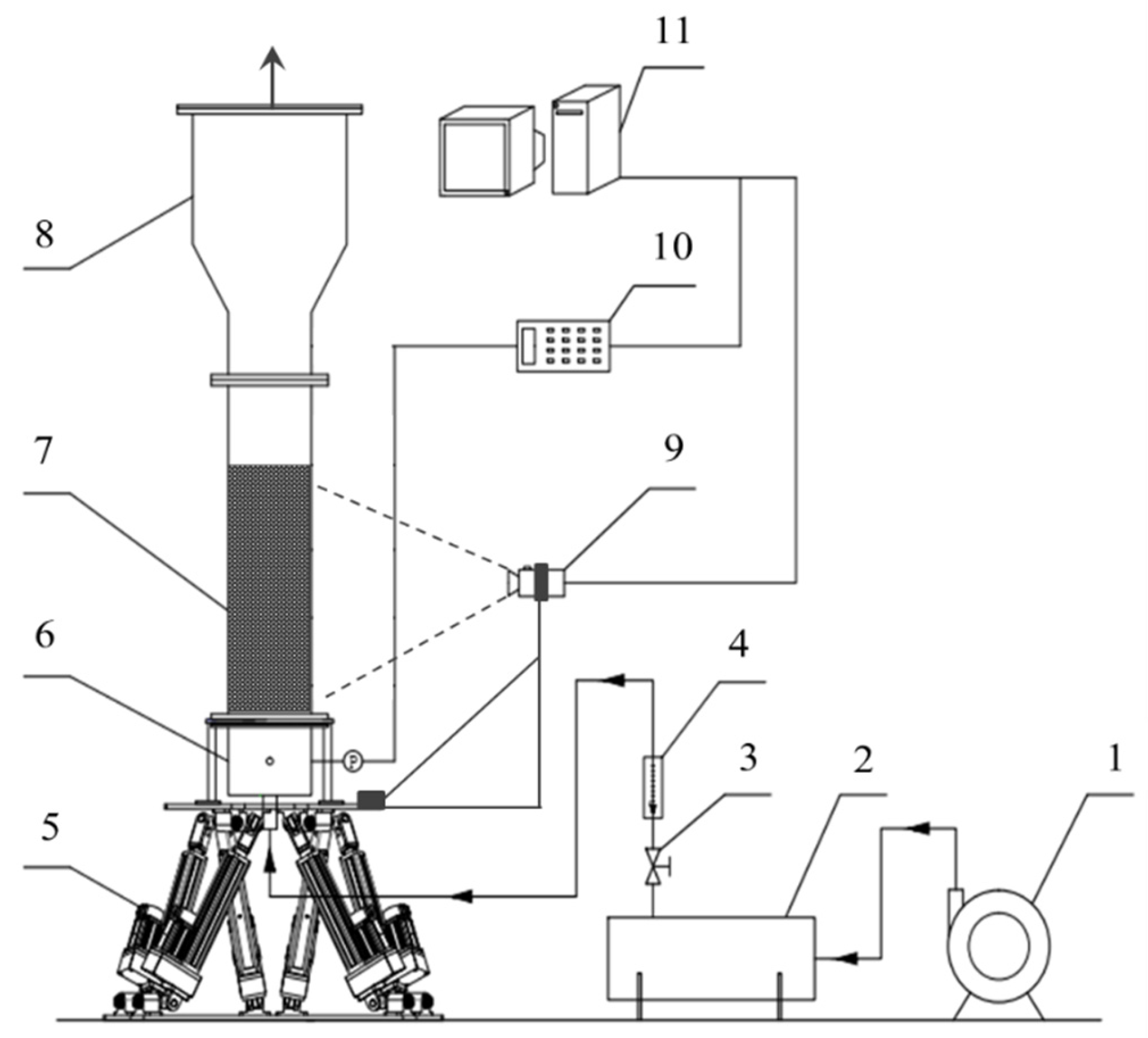
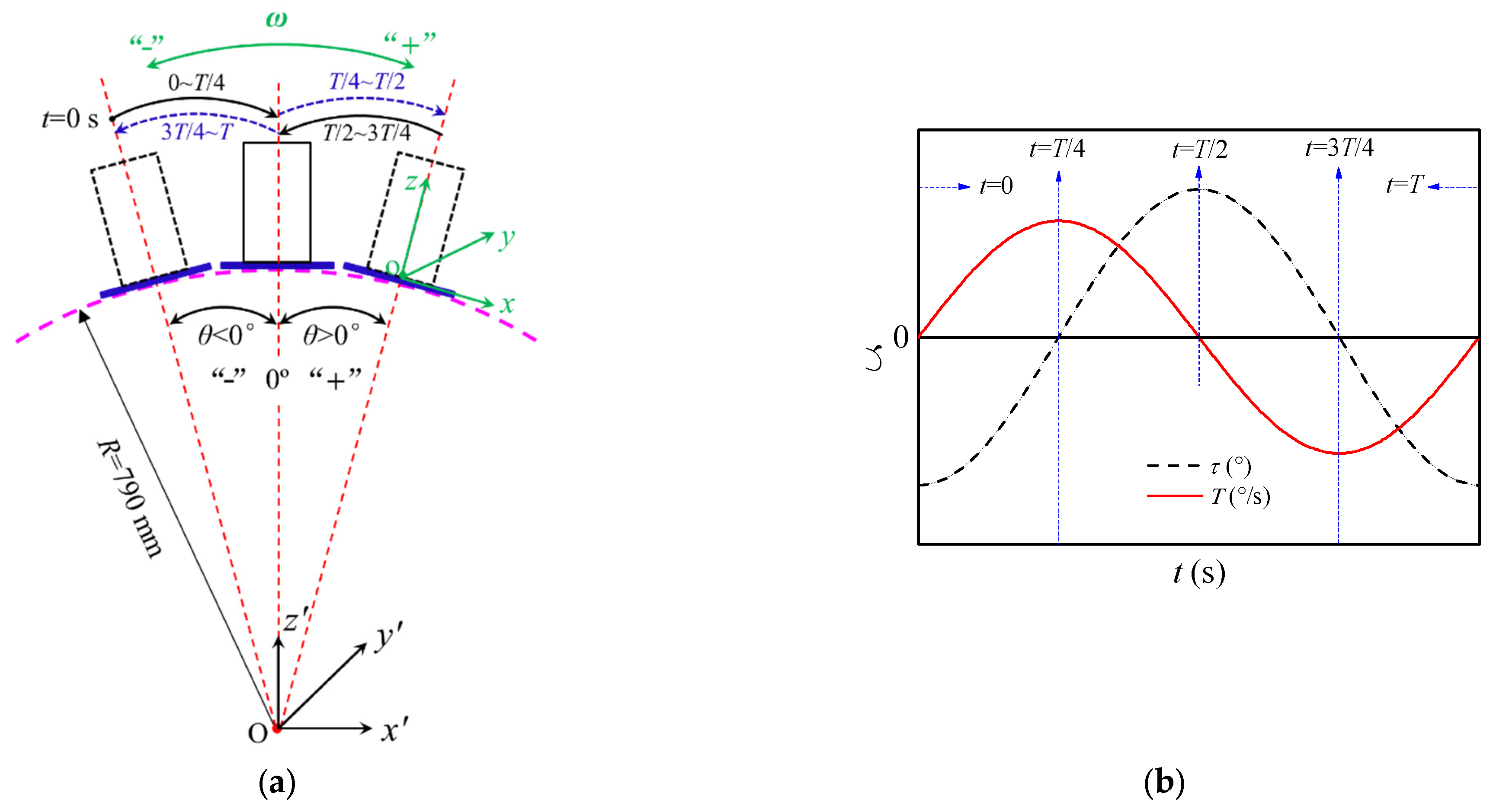
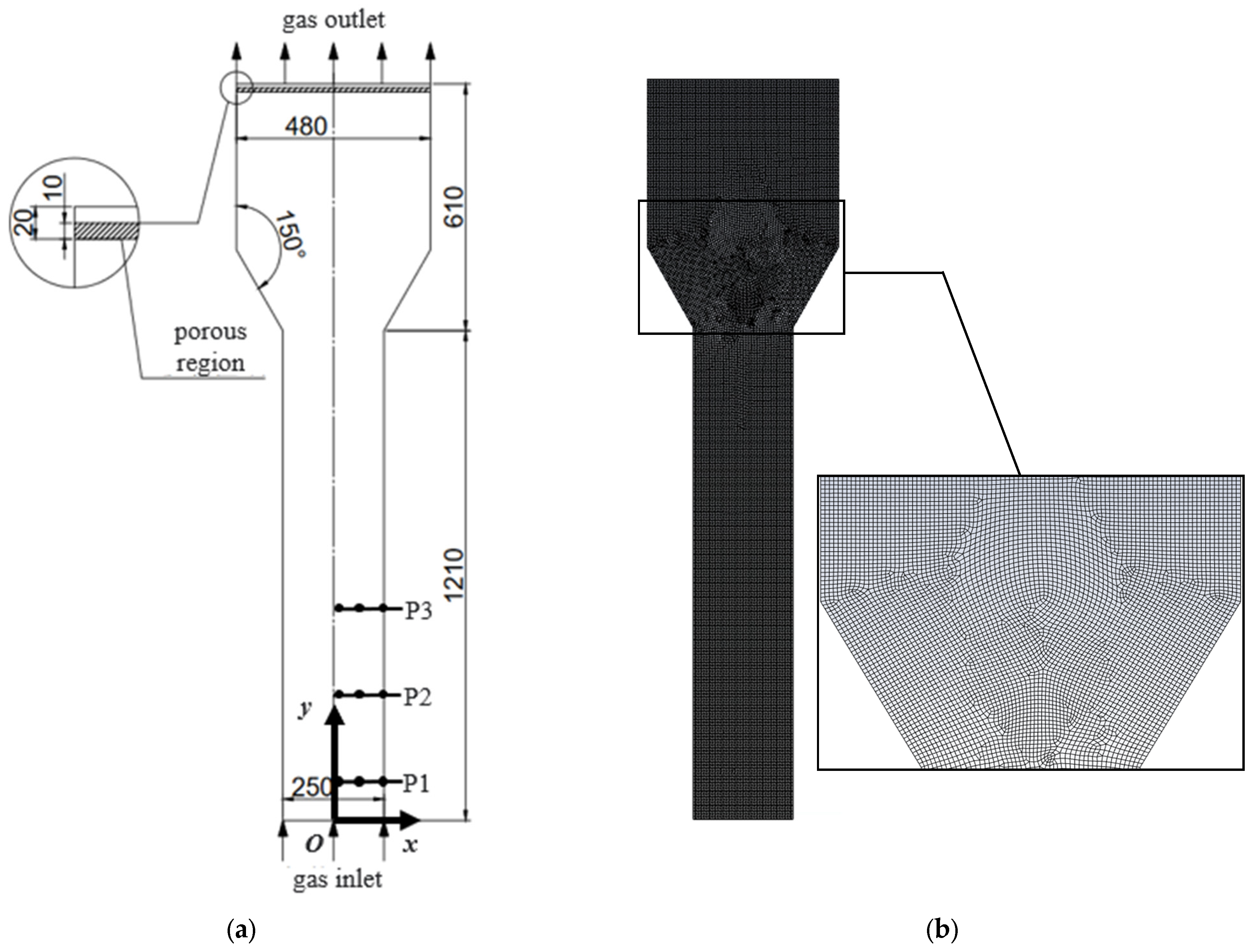

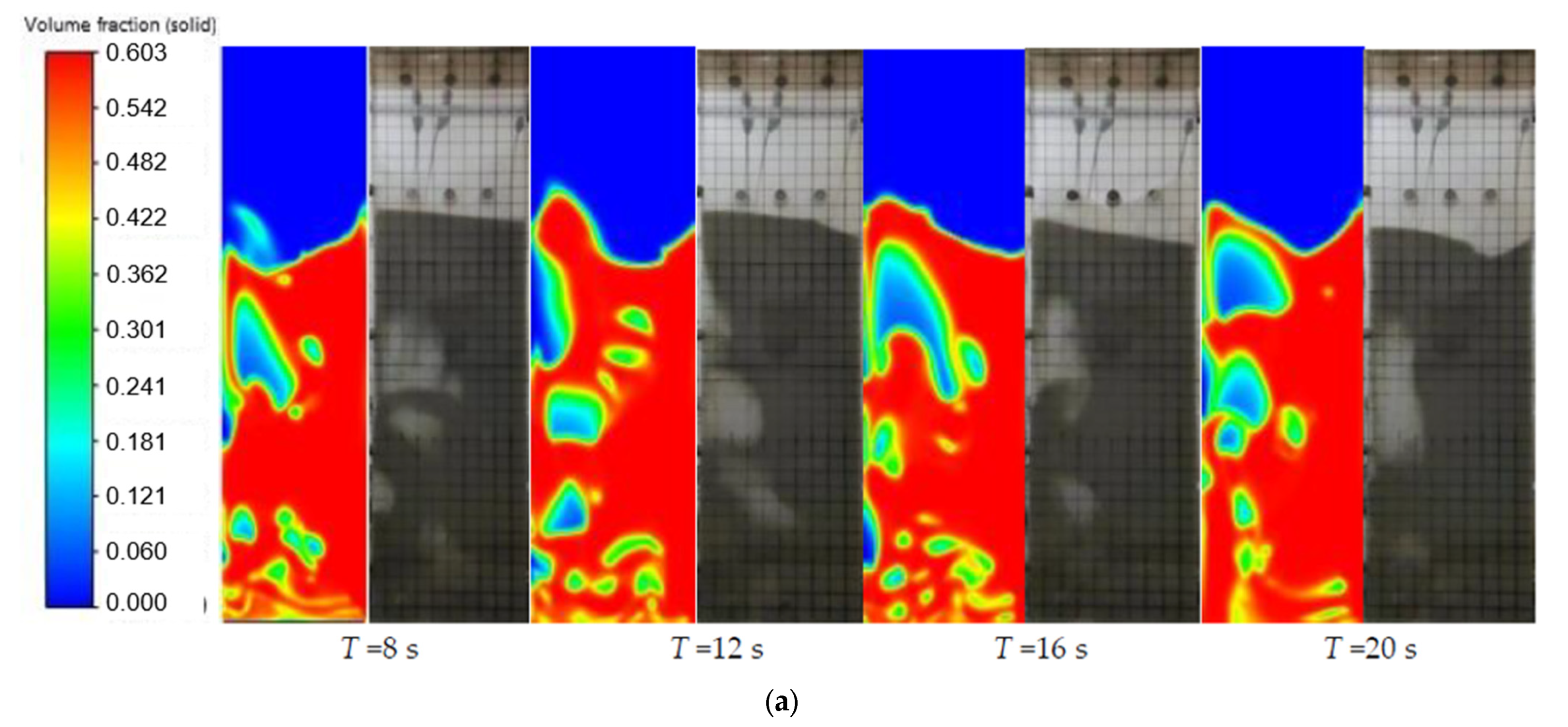

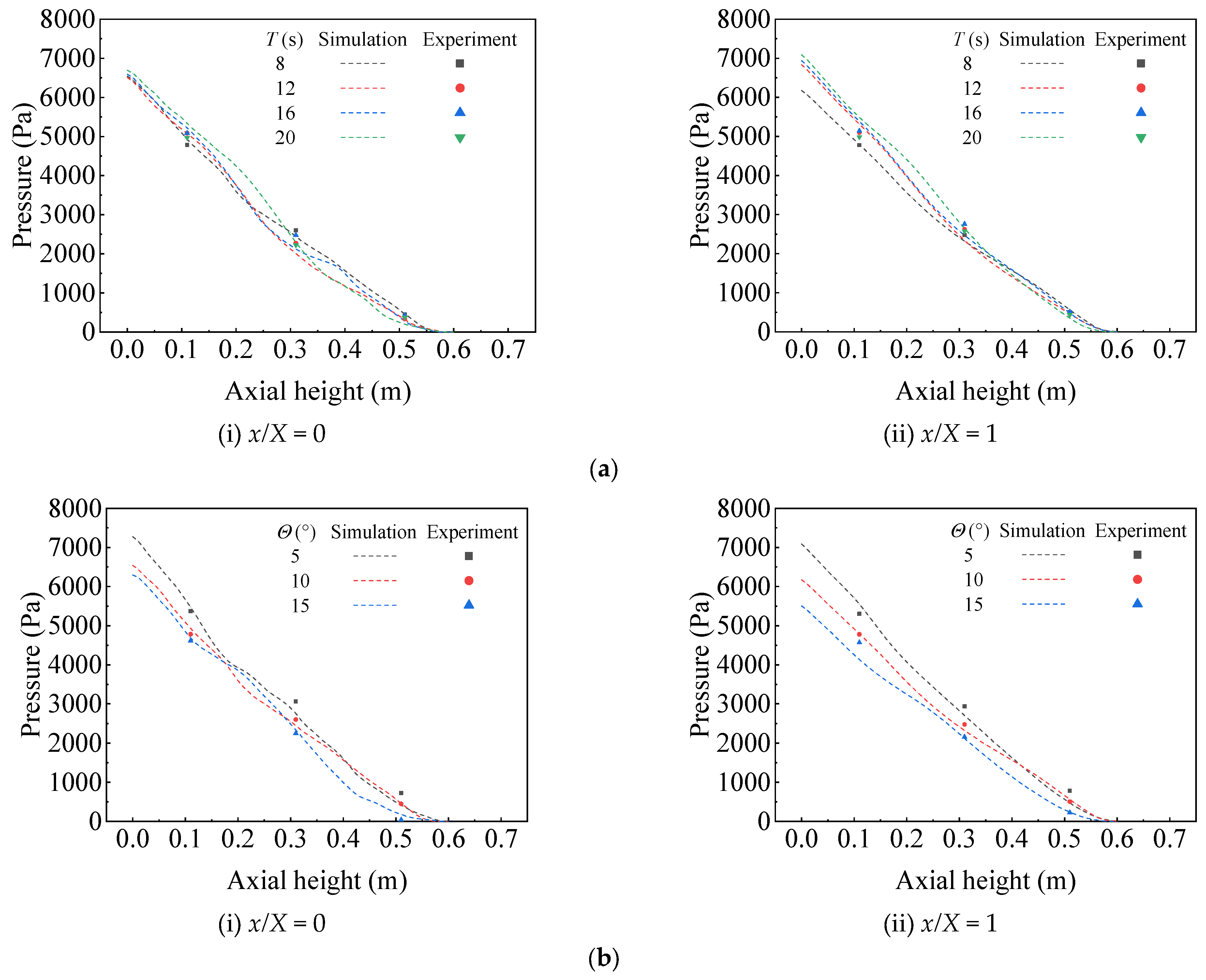
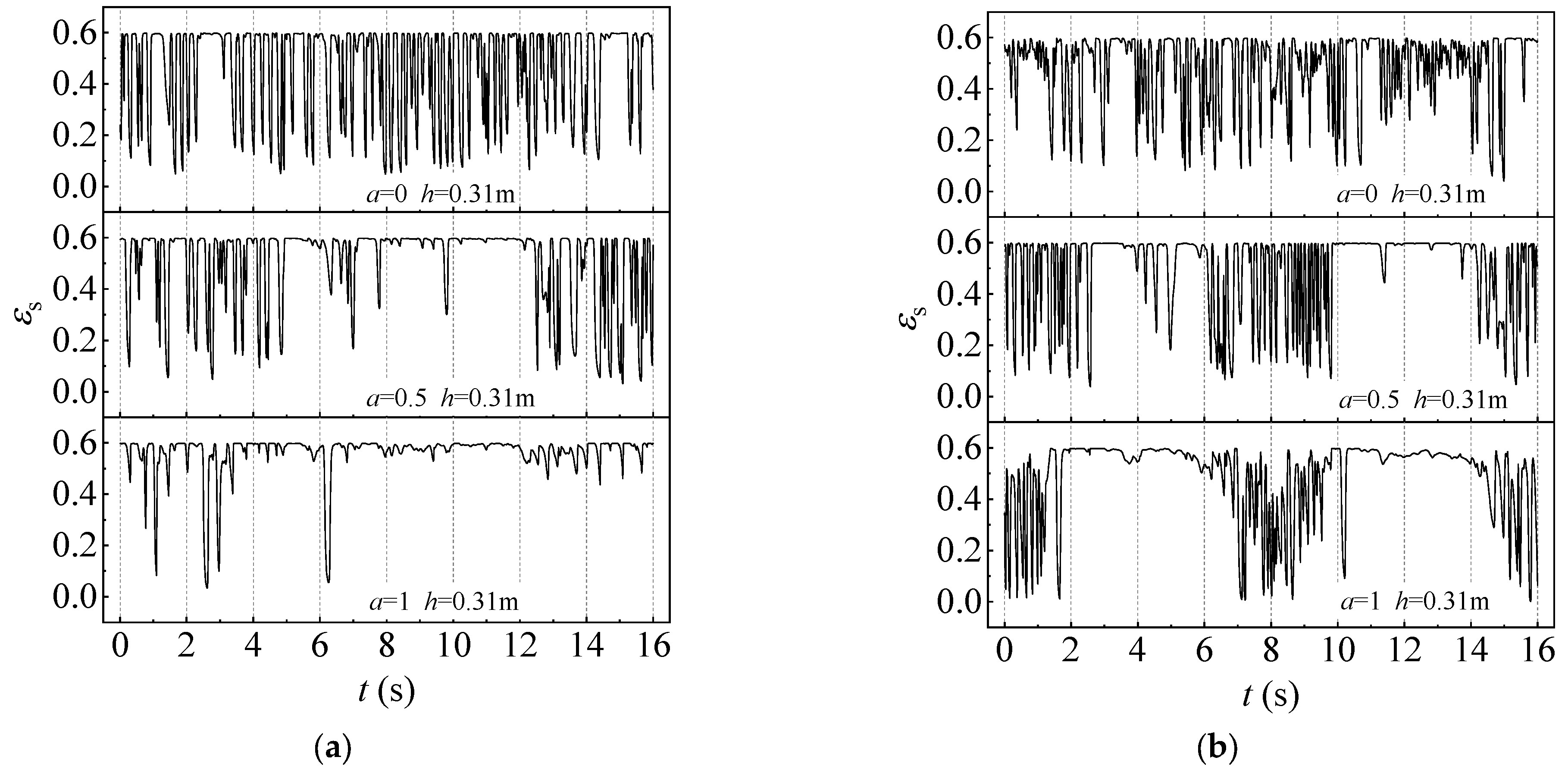


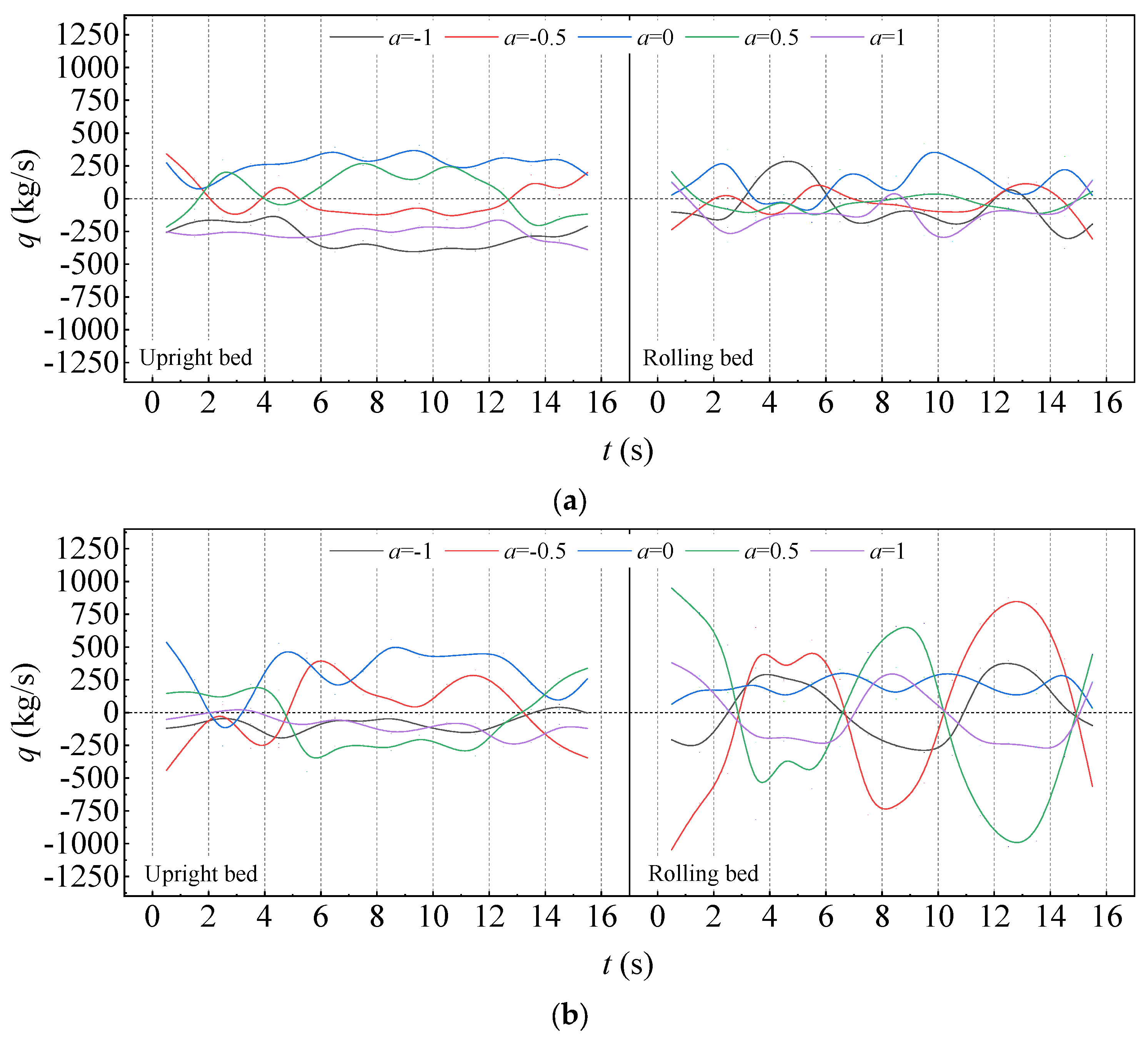
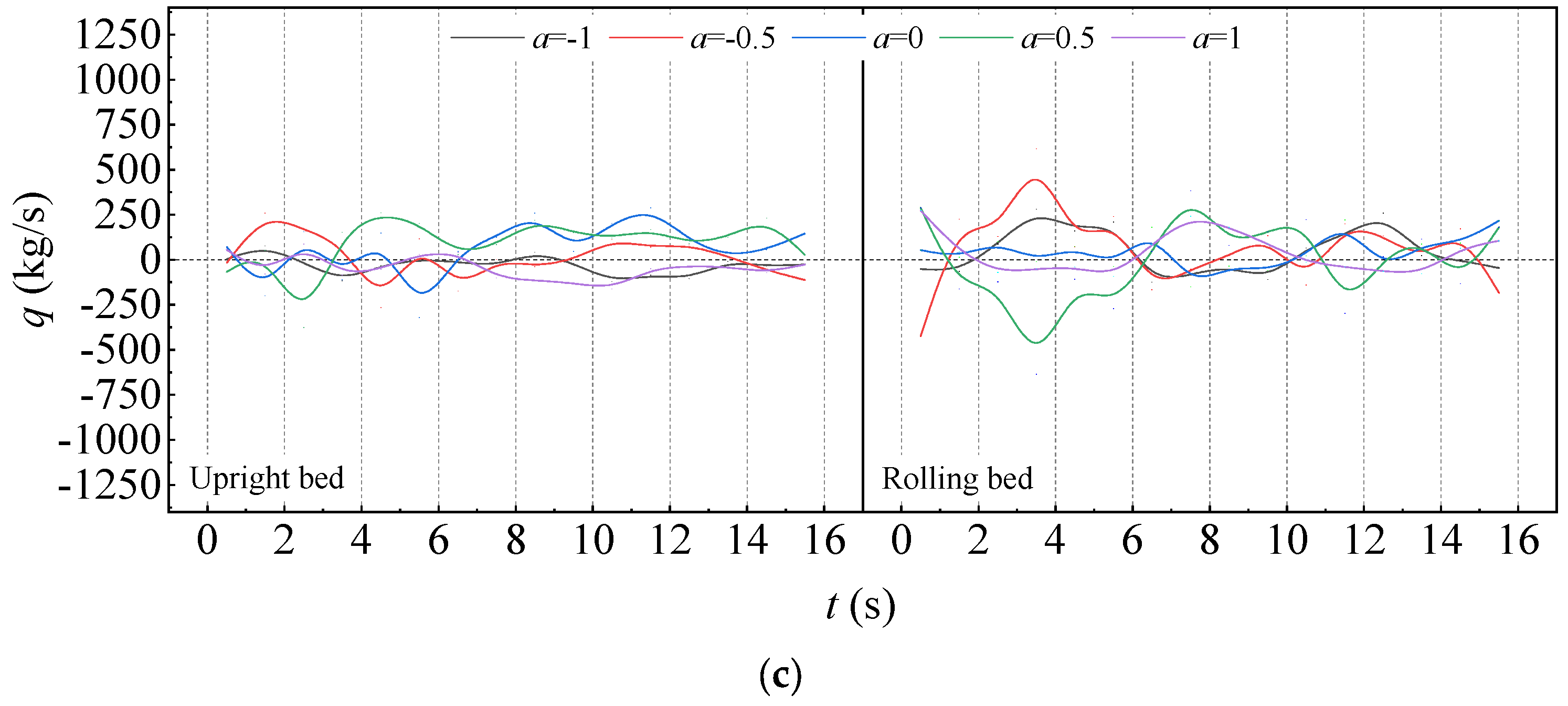
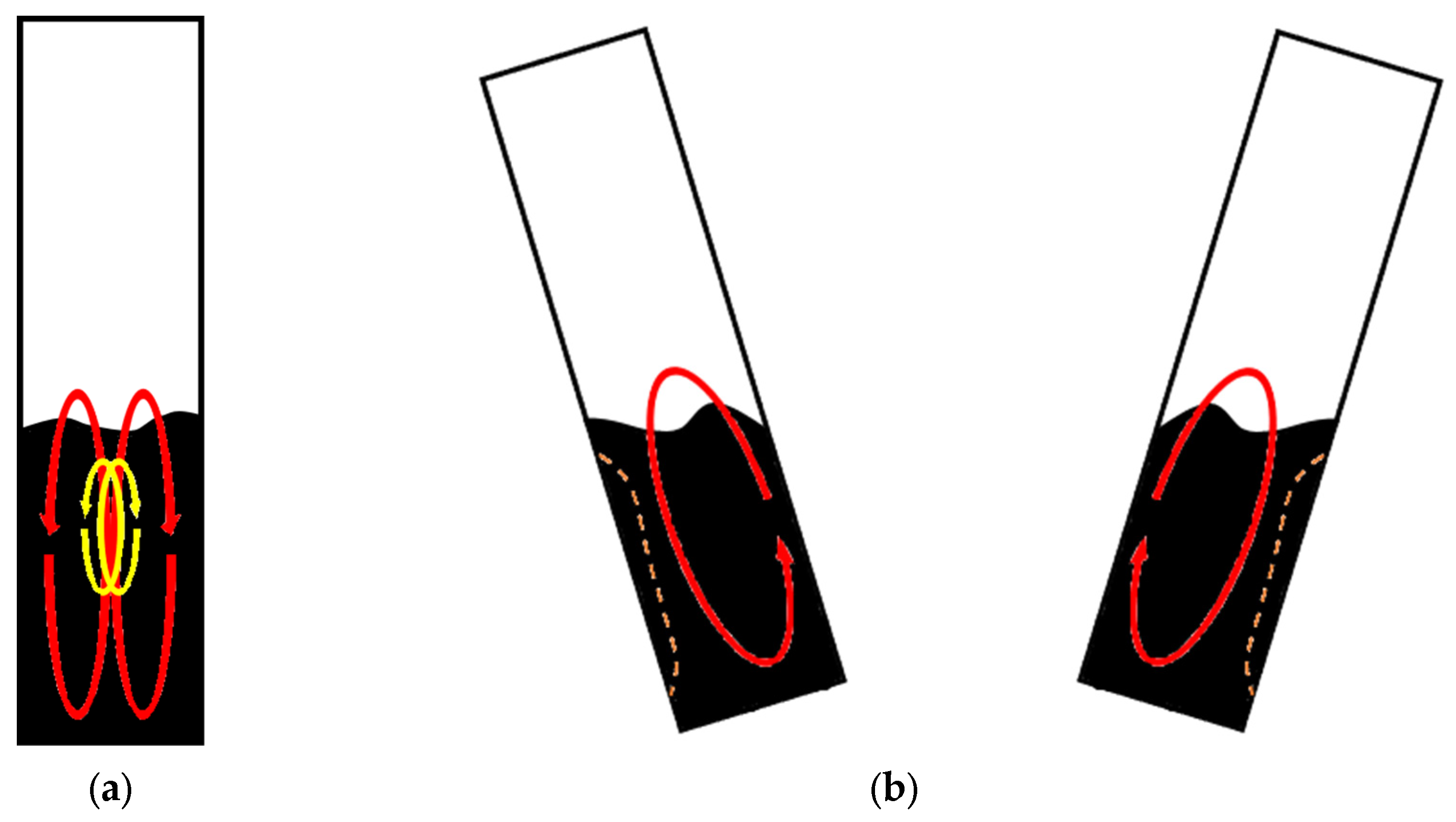
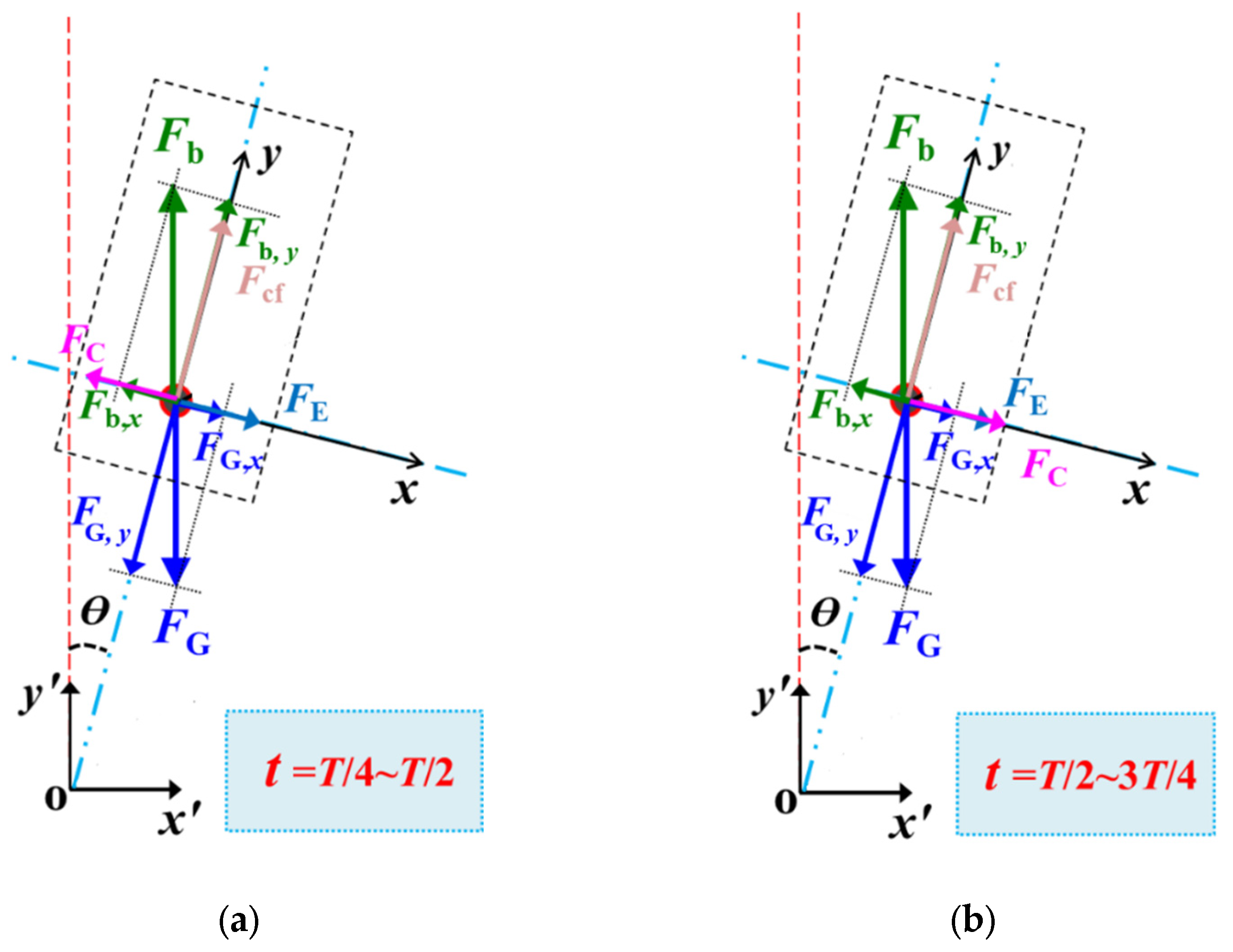
Disclaimer/Publisher’s Note: The statements, opinions and data contained in all publications are solely those of the individual author(s) and contributor(s) and not of MDPI and/or the editor(s). MDPI and/or the editor(s) disclaim responsibility for any injury to people or property resulting from any ideas, methods, instructions or products referred to in the content. |
© 2023 by the authors. Licensee MDPI, Basel, Switzerland. This article is an open access article distributed under the terms and conditions of the Creative Commons Attribution (CC BY) license (https://creativecommons.org/licenses/by/4.0/).
Share and Cite
Huang, J.; Wang, R.; Xu, R.; Wu, B.; Wang, D.; Liu, Y.; Zhang, S. Numerical Simulation of Dynamic Variation Characteristics of Particles in a Rolling Fluidized Bed. Processes 2023, 11, 1696. https://doi.org/10.3390/pr11061696
Huang J, Wang R, Xu R, Wu B, Wang D, Liu Y, Zhang S. Numerical Simulation of Dynamic Variation Characteristics of Particles in a Rolling Fluidized Bed. Processes. 2023; 11(6):1696. https://doi.org/10.3390/pr11061696
Chicago/Turabian StyleHuang, Jiale, Ruojin Wang, Rongsheng Xu, Banghua Wu, Dewu Wang, Yan Liu, and Shaofeng Zhang. 2023. "Numerical Simulation of Dynamic Variation Characteristics of Particles in a Rolling Fluidized Bed" Processes 11, no. 6: 1696. https://doi.org/10.3390/pr11061696
APA StyleHuang, J., Wang, R., Xu, R., Wu, B., Wang, D., Liu, Y., & Zhang, S. (2023). Numerical Simulation of Dynamic Variation Characteristics of Particles in a Rolling Fluidized Bed. Processes, 11(6), 1696. https://doi.org/10.3390/pr11061696




